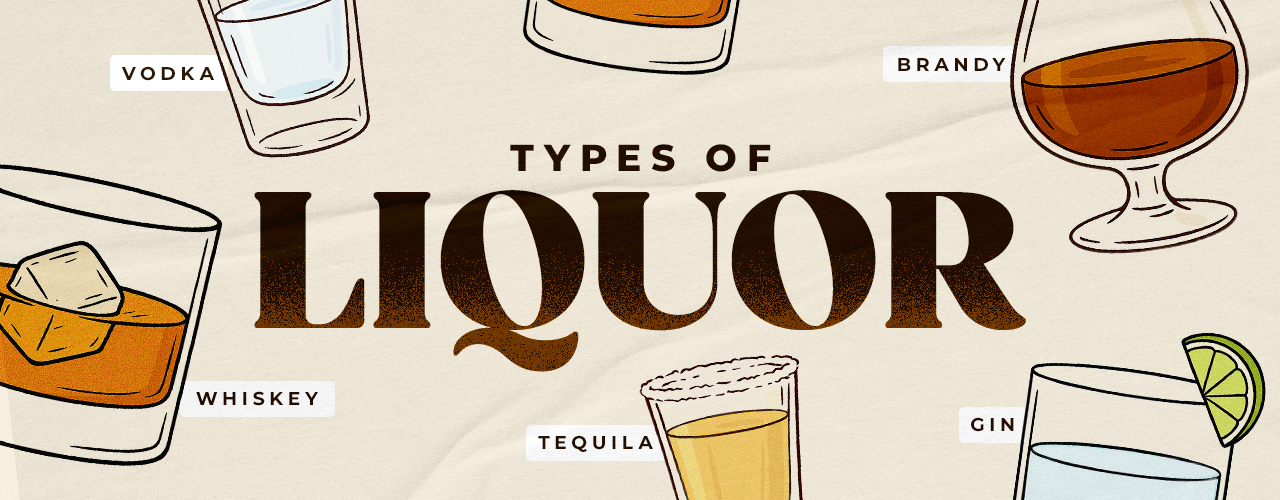
There are six primary types of liquor, each with its own distinct characteristics and uses in the bar industry: vodka, rum, tequila, gin, whiskey, and brandy. Vodka is a versatile spirit that can be used in a wide range of cocktails, while rum is often used in tropical drinks and baking. Tequila is a key ingredient in margaritas and other Mexican-inspired cocktails, and gin is known for its botanical flavors in classic cocktails like the martini. Whiskey encompasses various styles such as bourbon, scotch, and rye, each offering unique flavors for sipping or mixing. Lastly, brandy is a popular choice for after-dinner drinks and cooking applications. We deep dive into each of these distilled spirits, exploring their nuances, uses, and the different types within each category, so you can stock your bar with the foundational liquors you need to make your signature cocktails.
What Is Liquor?

Liquor is an alcoholic beverage that is produced through the fermentation and distillation of grains, fruits, vegetables, or sugar. What sets liquor apart from wine and beer is the distillation process it undergoes. Distillation involves heating the fermented liquid to separate alcohol from water and other components. This concentration process increases the alcohol content of the liquid, giving liquor a higher alcohol proof compared to beer and wine.
Liquor vs Liqueur
Liquors are primarily distilled from high-starch plants and have a high alcohol by volume (ABV) content, with most starting at 80 proof and increasing from there. Liqueurs are a subset of spirits with a lower ABV, typically falling between 15 and 60 proof. They are distilled from organic compounds such as herbs, berries, fruits, and nuts, resulting in often sweet and flavorful final products that can add depth and complexity to drinks. They also serve as aperitifs or digestifs, enjoyed before or after a meal to stimulate the appetite or aid in digestion.
Different Types of Liquor
Whiskey, vodka, rum, tequila, gin, and brandy are the main types of liquor. Each offers unique flavors and characteristics that cater to different preferences and cocktail recipes.
1. Tequila

Tequila is a unique spirit distilled from the agave plant, specifically the Weber Blue Agave, which is a cactus-like plant from the lily family. Premium tequila must be made from 100 percent Weber Blue Agave, while tequilas with less than 100 percent agave are known as mixtos, which are typically less expensive and lower in quality. The best tequilas are crafted from agaves that are eight to twelve years old. To be labeled as tequila, the spirit must originate from specific regions in Mexico, with the most notable being the city of Tequila in the state of Jalisco. Tequila can also be produced in Guanajuato, Michoacan, Nayarit, and Tamaulipas.
By law, all tequilas must undergo a double distillation process, although there are exceptions, such as the award-winning organic Casa Noble tequilas, which are triple distilled. Distillers use stainless steel copper pot stills or larger column stills to achieve the desired flavor profile before aging the tequila in barrels. There are five main types of tequila you can use in a tasting. Blanco tequila, also known as silver or platinum tequila, is unaged and offers a crisp, fresh agave flavor. Joven, also known as “gold” tequila, is a blend of blanco and reposado tequilas, often but not always mixed with additional coloring and flavoring. Reposado tequila, meaning "rested," is aged for a minimum of two months in stainless steel tanks or barrels, with a maximum aging period of 11 months. Anejo tequila must be barrel-aged for a minimum of one year but no longer than three years; if aged for more than three years, it is classified as extra anejo tequila.
- What Does Tequila Taste Like? Sweet agave with notes of citrus, soil, and pepper
- Is Tequila White or Brown Liquor? Unaged blanco is white liquor. Reposado and anejo are brown liquors.
- Types of Tequila: Blanco (silver) tequila, Joven (gold) tequila, Reposado tequila, Anejo tequila, Extra anejo tequila
- Popular Tequila Cocktails: Margarita, Paloma, Tequila Sunrise, Rosita, Ranch Water, El Diablo
Mezcal vs Tequila
Mezcal and tequila are both popular Mexican spirits, but they are two unique beverages. Mezcal is made from various types of agave plants, while tequila is specifically made from blue agave, resulting in a more earthy and herbal taste. Mezcal is typically produced using traditional methods, including roasting the agave in underground pits, giving it a smoky quality that enhances spicy drinks, like our spicy grapefruit mezcal margarita recipe.
2. Brandy

Brandy is a single-distilled wine-based spirit aged in barrels, which imparts oaky, caramel, and vanilla essences into the fruity base flavor. The main types of brandy include grape brandy, fruit brandy, and pomace brandy. Grape brandy, made from fermented grapes, is the most common type. Fruit brandy, produced from fruits like apples, cherries, or pears, offers a diverse range of flavors. Pomace brandy, also known as grappa, is made from the leftover grape skins, seeds, and stems after winemaking, resulting in a bold and distinctive taste. Unlike some spirits that are tied to specific regions, Brandy can be produced anywhere, allowing for a diverse range of styles and expressions to emerge in the market.
The name "brandy" is derived from the old Dutch word brantwijn, which translates to "burnt wine." This term originated from the practice of distilling grape juice with fire, or more accurately, with enough heat to bring the liquid to a boil. During the seventeenth century, brandy became so popular that the anglicized word "brandywine" found its way into many early American folk songs, particularly those from the Appalachian region. Eventually, the name was shortened to simply "brandy." Over time, this drink evolved into the fruit-forward sweet spirit we now know today.
- What Does Brandy Taste Like? Fruity and sweet with notes of caramel, vanilla, and oak
- Is Brandy White or Brown Liquor? Brandy is considered a brown liquor.
- Types of Brandy: Grape brandy, Fruit brandy, Pomace brandy
- Popular Brandy Cocktails: Sidecar, Brandy Alexander, Vieux Carre, Brandy Smash
Cognac vs Brandy
Cognac (pronounced as "kown-yak") and brandy are both types of distilled spirits that originate from wine. Cognac is a specific type of brandy that must be produced in the Cognac region of France and adhere to strict regulations. It is typically aged in oak barrels, resulting in a smooth, complex flavor profile with notes of fruit, spice, and oak. Brandy, on the other hand, is a broad category of spirits made by distilling wine or fermented fruit juice. It is single-distilled, whereas cognac undergoes a double distillation process.
3. Vodka

Vodka is a clear, colorless liquor that is typically made from fermented grains such as wheat, rye, or barley. Vodka can also be made from potatoes, grapes, or other fruits. Unlike brown liquors such as whiskey or rum, vodka is not aged in barrels. Instead, it is typically distilled multiple times to achieve a smooth and neutral flavor profile. This makes vodka an ideal base for a wide range of cocktails and mixed drinks. Flavored vodka is a popular variation that involves infusing the spirit with additional ingredients like fruits, herbs, or spices, and sometimes sweetening or coloring it to create a distinct taste. Liquor connoisseurs debate whether Russia or Poland can claim its place of origin. Regardless of where it came from, vodka is now produced across the globe and stands as the most favored spirit in the United States.
The name "vodka" itself comes from the Slavic word voda, meaning water. The water used in the distillation process greatly affects vodka's flavor, as it comprises 60 percent of vodka's composition. Some of the most expensive vodkas on the market are made from the purest global waters, such as the Blue Spring of New Zealand and Agua Clara Spring in the Andes Mountains of Chile. In addition to water quality, the distillation technique and types of filtration used in the production process also play a significant role in shaping vodka's flavor profile. These factors contribute to the wide range of flavors and qualities found in different vodkas on the market today.
- What Does Vodka Taste Like? Clean and neutral with subtle notes of almond, citrus, apple, or pepper, depending on the starch and water used
- Is Vodka White or Brown Liquor? Vodka is a white liquor
- Types of Vodka: Wheat vodka, Rye vodka, Potato vodka, Flavored vodka, Fruit vodka, Barley vodka
- Popular Vodka Cocktails: Moscow Mule, Cosmopolitan, Bloody Mary, Vodka Martini, Espresso Martini, Screwdriver, White Russian, Vodka Cranberry
Tequila vs Vodka
Tequila is a distilled spirit made from the blue agave plant, primarily produced in Mexico, known for its earthy and robust flavors. On the other hand, vodka is a colorless and odorless spirit that can be made from various ingredients such as grains or potatoes, offering a neutral taste profile. Tequila is often used in cocktails like margaritas and palomas, adding a distinct flavor, while vodka serves as a versatile base for a wide range of mixed drinks due to its neutral taste.
4. Whiskey

Whiskey is an amber-colored distilled alcoholic beverage made from fermented grain mash, such as corn, barley, rye, and wheat. It is typically aged in wooden casks and has a minimum alcohol by volume (ABV) of 40%. The term whiskey encompasses diverse whiskey varieties, each with its own distinct characteristics and production methods. Single malt whiskey, for example, is made from 100% malted barley at a single distillery, often in Scotland, where it is known as Scotch whiskey. A single malt is a pot-distilled spirit that comes from one single distillery and is aged in oak barrels. On the other hand, a Scotch blend is comprised of several single malts from different distilleries that are blended. Grain whiskies are another category commonly used in Scotch whiskey blends to link the various single malts together. Irish whiskeys are typically triple-pot distilled, giving them lighter and mellower flavors. Unlike Scottish distillers, most Irish distilleries do not burn peat to dry their malted barley, resulting in a lack of smoky characteristics.
Japanese whiskies have been gaining global traction, and Japan is now the second-largest producer of single malt whiskey worldwide. The terroir of the volcanic soil in Japan imparts a smoky, dry sweetness to their whiskies. Bourbon, a uniquely American invention, is a type of corn whiskey that comes in single-barrel and small-batch varieties. Tennessee whiskey, similar to bourbon, must be made from a mash bill containing at least 51% corn and aged in new charred American white oak barrels. However, Tennessee whiskey is distinguished by an additional step where the distillate is filtered or mellowed through a 10-foot column of sugar maple wood charcoal. Distilled from a mash bill containing a minimum of 51% rye grain, aged in new charred oak barrels, and bottled at least 80 proof, rye whiskey is beloved for its bold, peppery taste. Canadian whiskey is crafted from fermented grains such as corn, rye, and barley and undergoes a maturation process of at least three years in wooden barrels. Since it typically has a higher corn than rye blend, Canadian whiskey is recognized for its smooth and light profile. Additionally, it is permissible for Canadian whisky to incorporate caramel coloring and other flavorings prior to bottling, further enriching its taste profile.
- What Does Whiskey Taste Like? With so many varieties, whiskey’s flavor profile ranges from spicy, woody, and smoky, to sweet, caramel, vanilla, and fruity
- Is Whiskey White or Brown Liquor? Most whiskeys are brown liquors. The exception is unaged, white whiskey.
- Types of Whiskey: Bourbon whiskey, Tennessee whiskey, Rye whiskey, Scotch whisky, Irish whiskey, Canadian whiskey
- Popular Whiskey Cocktails: Old Fashioned, Manhattan, Whiskey Sour, John Collins, Irish Coffee, Mint Julep, Vieux Carre, Highball, Lynchburg Lemonade, Sazerac
Whiskey vs Bourbon
Whiskey is a broad category that includes various styles such as Scotch, Irish, and Canadian whiskey. It is typically made from a fermented grain mash and aged in wooden barrels. On the other hand, bourbon is a specific type of whiskey that must be made in the United States, primarily from corn, and aged in new charred oak barrels. Bourbon tends to have a sweeter flavor profile compared to other types of whiskey due to its high corn content.
Whiskey vs Whisky
The main difference between whisky and whiskey lies in the spelling, reflecting their original Scots- and Gaelic-derived names, uisge beatha, meaning "Water of Life". American ‘whiskey’ acquired the 'e' due to Irish immigration in the 18th century, while Scotch whisky is always spelled without the 'e.' To be officially called Scotch whisky, the spirit must mature in oak for at least three years and undergo production and maturation in Scotland. Single malt Scotch whisky must be crafted from 100% malted barley. Irish whiskey, on the other hand, is always spelled with the 'e,' and it distinguishes itself by using little to no peat, resulting in a lack of smokiness. Irish whiskey may contain a blend of malt distillate, barley distillate, and grain spirit, and it is distilled three times. Similar to Scotch whisky, Irish whiskey must mature for a legal minimum of three years.
5. Gin

Originally known as genever, which is Dutch for juniper, gin derives its name from its dominant flavoring ingredient. While genever is the predecessor of modern gin, it is characterized by a maltier and richer flavor profile, reminiscent of whiskey. The process of making gin involves infusing or macerating a variety of botanicals with a neutral grain spirit, which is then pot distilled. To be classified as gin, the final product must contain at least 37.5% pure alcohol in the total volume of liquid (ABV). Juniper must be the predominant flavor in gin; without it, the liquor cannot be considered gin. Gin has a rich history dating back to the 1500s in Holland. It gained popularity in America during the prohibition era, as it was used in home distillation due to its status as an unaged spirit. Today, mixologists enjoy playing with the spirit’s varied botanical qualities.
The flavor of gin is derived from the types of botanicals used in the distillation process. While juniper forms the base, additional natural ingredients such as coriander, orange peel, angelica, lemon peel, and cardamom are commonly added to create a complex flavor profile. London Dry Gin, distilled from corn, offers a smoother version of the Dutch gin made with malted barley, boasting a strong juniper flavor and a dry finish. Old Tom Gin, a historical style of gin, is slightly sweeter than London Dry, offering a unique twist on the classic spirit. Navy Strength Gin, with a minimum of 57% ABV, packs a punch with its higher proof, catering to those seeking a more robust drinking experience. Plymouth Gin, a specific style produced in Plymouth, England, is known for its softer and earthier flavor compared to London Dry. Flavored gins, such as pink gin, are infused with fruit, floral, and herbal flavors after distillation, offering a refreshing and aromatic twist on the traditional spirit.
- What Does Gin Taste Like? Piney, herbal juniper berries are the dominant flavor, accompanied by other botanicals.
- Is Gin White or Brown Liquor? Gin is an unaged white liquor
- Types of Gin: London dry gin, Plymouth gin, Old Tom gin, Navy strength gin, Modern craft gins
- Popular Gin Cocktails: Gin and Tonic, Negroni, Martini, French 75, Bees Knees, Gin Fizz
Gin vs Vodka
Gin is a clear spirit that is primarily flavored with juniper berries, giving it a unique botanical taste. It is commonly used in classic cocktails like the gin and tonic or the Negroni. On the other hand, vodka is a neutral spirit that is typically distilled multiple times to achieve a smooth and clean flavor profile. Vodka is versatile and can be mixed with a wide range of ingredients, making it a staple in many cocktails and mixed drinks.
Gin vs Whiskey
Gin, a clear spirit flavored with botanicals like juniper berries, offers a versatile base for classic cocktails such as the martini or gin and tonic. On the other hand, whiskey, a distilled alcoholic beverage made from fermented grain mash, provides a complex and rich flavor profile that is ideal for sipping neat or in cocktails like the Old Fashioned or Manhattan.
6. Rum

Rum is a sugar cane distillate beloved for its balmy Caribbean image, making it a popular choice for tiki bar drinks. While rum is often associated with the West Indies, it is produced in various regions around the world, from South Africa to South America to Asia. To make rum, sugar cane is harvested and crushed to extract the juice from the stalks. This sweet juice is then fermented with yeast before being distilled in a column still, pot still, or a combination of both methods. Some rums are made by cooking sugar cane juice first, creating a syrup or molasses that results in a heartier flavor profile.
Once associated with pirates, rum has evolved from its historical roots to become a refined beverage better suited to a yacht than Queen Anne's Revenge. Today, there are three main types of rum: light, gold, and dark, with a few sweet, spiced rums typically reserved for cocktails. Light or white rums are aged in steel tanks or uncharred barrels to maintain their clarity. Gold rums undergo barrel aging, though not as extensively as dark rums. Dark rums are distilled from caramelized molasses derived from burnt sugar cane and are aged in charred barrels for a deeper color and a more robust flavor.
- What Does Rum Taste Like? Ranges from sweet, mild, and verdant flavored light rums, to decadent, spicy, and nuanced flavored dark rums
- Is Rum White or Brown Liquor? Rum can be classified as either white or dark liquor, depending on the aging process and ingredients used.
- Types of Rum: Light rum, Gold rum, Dark rum, Spiced rum
- Popular Rum Cocktails: Mojito, Pina Colada, Daiquiri, Dark n’ Stormy, Mai Tai, Cuba Libre, Rum Punch, Hurricane, Rum Runner, Zombie, Jungle Bird
Rum vs Whiskey
Rum is made from sugarcane byproducts, such as molasses or sugarcane juice, and is typically aged in oak barrels. It has a sweet and tropical flavor profile, making it a versatile choice for cocktails. On the other hand, whiskey is made from fermented grain mash and aged in wooden casks, giving it a complex and robust taste with notes of caramel, vanilla, and spice.
Cachaca vs Rum
Cachaca (pronounced as "kuh-chaa-kuh") is a Brazilian spirit made from fermented sugarcane juice, giving it a unique grassy flavor. It is the key ingredient in the famous Caipirinha cocktail. Rum, on the other hand, is made from either sugarcane juice or molasses and is produced in various countries. Rum comes in different styles, such as light, dark, and spiced, each offering its own flavor profile.
Back to TopLiquor FAQs
Now that you're familiar with the most foundational liquor categories, we answer some common questions you may still have about distilled spirits below.
What Is Hard Liquor?
Hard liquor, also known as spirits or distilled spirits, is a type of alcoholic beverage that is produced through the process of distillation. Distillation involves heating a fermented liquid to create vapor, which is then condensed back into liquid form to increase the alcohol content and remove impurities. Examples of hard liquor include vodka, rum, whiskey, tequila, gin, and brandy. Hard liquor typically has a higher ABV than beer or wine, making it a popular choice for creating strong and flavorful cocktails.
What Is Brown Liquor?
Brown liquor, also known as dark liquor, encompasses a variety of spirits aged in oak barrels, creating their distinctive dark hues and rich flavors. Examples of brown liquor include bourbon, whiskey, rum, and brandy. These spirits are often enjoyed neat, on the rocks, or as the base for classic cocktails like an Old Fashioned and Manhattan.
What Are Distilled Spirits?
Distilled spirits, also known as hard liquors, are alcoholic beverages produced by distilling fermented grains, fruits, or vegetables. The distillation process involves heating the liquid to create steam, which is then cooled and collected as a concentrated form of alcohol. Distilled spirits typically have a higher alcohol content than other types of alcoholic beverages, such as beer or wine, ranging from 40% to 50% alcohol by volume. Common types of distilled spirits include vodka, rum, whiskey, tequila, gin, and brandy. Each type of spirit has its own unique flavor profile and is often enjoyed neat, on the rocks, or as a base for cocktails.
Spirits vs Liquor
The terms liquor and spirits are interchangeable, representing the wide range of distilled alcoholic drinks available for commercial use. Liquor, also known as spirits, refers to alcoholic beverages made from grains or other plants that are fermented and distilled into "hard alcohols."
Understanding the types of liquor is essential for any commercial business or bartender. It allows businesses to offer a diverse selection of drinks to cater to different customer preferences and trends. For bartenders, knowing the characteristics and uses of various liquors can enhance their mixology skills and provide a better customer experience. Whether you want to become a bartender or update your cocktail menu, a solid understanding of liquor types is crucial in the commercial beverage industry.





